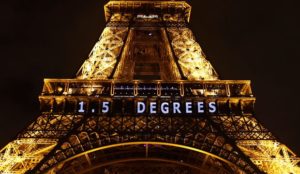Update on the Paris Climate Accord • Cap-and-Trade and other Mitigation too

 As many of you know, the minimum 55 countries needed to ratify the Accord have done so. How great is that?!
As many of you know, the minimum 55 countries needed to ratify the Accord have done so. How great is that?!
In fact, the number of “parties” ratifying so far is 81. India was a major “grab” for doing something about decelerating GHG emissions and slowing global warming.
Now less worry about it being unwound by U.S. politicians after the Presidential election as the treaty will enter into force as of November 4th.
The Washington Post’s excellent reporter on the environment, Chris Mooney, said in his 10/5/16 piece about the Accord: “Now the focus shifts to more thorny issues: how to limit the warming of the planet to ‘well below’ 2 degrees Celsius above preindustrial levels, as the Paris Agreement calls for.
Then, the obvious: “It’s far easier for countries to sign an agreement on paper than it is for them to meet their pledges to reduce carbon-dioxide emissions, let alone increase those ambitions over time.”
Mooney quotes Jorgen Olesen, a Aarhus University/Denmark professor who says: “…there also needs to be significant investment in adaptation measures. ‘It’s too late to only think about mitigation. We probably need to adapt to a 3- or 4-degree world.'” Adaptation measures include sequestration of CO2 which I’ve written about, most recently here, if you missed it.
Another academician, Glen Peters of the Center for International Climate and Environmental Research/Oslo, advises: “At the moment, most studies suggest the current pledges put us on a pathway to around 3 [degrees Celsius]. The current pledges move us away from high-end scenarios like 4 [degrees Celsius], but they are not sufficient to keep us below 2 [degrees Celsius].”
The world’s trajectory toward 2 degrees Celsius will be crossed in less than 15 years, or by 2030, according to other scientists who are quoted in the article, and in other media.
U.S. Sec. of State John Kerry said real transformation will be led by the private sector investing in new technologies and renewables. He adds that government isn’t going to solve the problem but will be a solutions catalyst.
Air Conditioners a threat
In a press briefing back in July, Kerry said that air conditioners are as big as threat as is ISIS. Now, thankfully, the historic, 1989 Montreal Protocol banning CFCs (Chlorofluorocarbons) has been amended to ban HFCs (Hydrofluorocarbons) as well.
“The use of hydrofluorocarbons is unfortunately growing,” Kerry said. “Already, the HFCs use in refrigerators, air conditioners, and other items are emitting an entire gigaton of carbon dioxide-equivalent pollution into the atmosphere annually. Now, if that sounds like a lot, my friends, it’s because it is. It’s the equivalent to emissions from nearly 300 coal-fired power plants every single year.” (Yikes!) Kerry’s statement about HFCs was widely reported, from Fox News to Jihad Watch.
Cap-and-Trade in CA
One measure of global warming mitigation is increasing tree cover.
In the Oct/Nov issue of Nature Conservancy magazine, an article reports on the Greenhouse Gas Cap-and-Trade Program in CA. The program “[establishes] an aggregate GHG allowance budget for covered entities (cement manufacturing, electric utilities, etc.) and [provides for] a trading mechanism for compliance instruments.” However, only 8% of an entity’s GHG emissions may be offset.
A compliance instrument, in case of the magazine article, is the more recent inclusion of sustainably managed forest projects as qualifying offsets to CO2. This helps the Yurok Native American tribe of CA which is using the cap-and-trade cash payments to restore its Garcia River Forest, a former timberland. Restoration includes conserving the salmon habitat there, and a general effort to preserve the Yurok culture.
The Garcia River Forest is among dozens nationwide that are eligible for cap-and-trade in CA due to considerable research and effort by The Nature Conservancy since 1994, even before the Kyoto Protocol of 1997 where forests were not recognized as carbon-offsetting.

What Are Some States Doing About Climate Change?
Oregon is addressing how climate change policies that could work in urban areas might cause difficulties for rural businesses.
Disney has bought carbon offset credits from Louisiana which is increasing its reforestation work in the state, including preparing sites, buying trees and using a carbon accounting firm to track emissions reductions.
In Kansas, The Nature Conservancy is helping wind farm developers identify sites that offer the least environmental impact, such as to migratory birds and certain native species.
Connecticut has been the first to enact what’s called PACE (Property Assessed Clean Energy) legislation. My firm, DW-GREEN Associates, is recommending it to clients for help in affording green building retrofits at very low interest rates from loans secured by the properties.